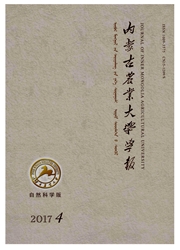

 中文摘要:
中文摘要:
在内蒙古和林县对不同种植模式苜蓿人工草地土壤线虫群落种类、优势属及区系的变化进行了研究。结果表明,不同种植模式苗蓿地共捕获23属线虫,不同种植模式影响土壤线虫数量的分布,土壤线虫数量大小顺序为:间行混播〉同行混播〉单播苜蓿〉休闲地,种植苜蓿增加了土壤线虫的总数量及土壤线虫种类优势属的数量。不同种植模式影响苜蓿地土壤线虫群落成熟度指数(MI)及植物寄生线虫成熟度指数(PPI),苜蓿与雀麦间行混播地MI指数显著高于其它种植模式,而PPI指数显著的低于其他种植模式;不同种植模式影响土壤线虫群落富集指数(EI)和结构指数(SI),苜蓿与雀麦混播模式下EI、SI值最高,表明苜蓿与雀麦混播能使土壤养分状况好转,且食物网相对稳定成熟、受干扰程度较小。
 英文摘要:
英文摘要:
We studied on the change of Alfalfa grassland soil nematode community types ; dominant genera and Flora under Different planting patterns, the results showed that 23 genera of nematode were captured in Different planting modes of alfalfa grassland and its population size was in the order of Row of mixed sowing 〉 peer mixed sowing 〉 weak Mu 〉 leisure. Planting alfalfa increased the total number of soil nematodes and soil nematode dominant genera number. Different planting modes of alfalfa influenced Soil nematode community maturity index ( MI ) and plant parasitic nematode maturity index ( PP! ), Alfalfa and Brome row sowing MI index were significantly higher than that of other planting patterns, While the PPI index is significantly lower than that of other planting patterns ; different planting patterns effected the soil nematode community enrichment index ( EI ) and structure index ( SI ) and the alfalfa and Brome mixture sowing mode got the highest EI and SI showed that in this mode The soil nutrient condition was better and the interference was smaller and had relatively stable and mature food network.
 同期刊论文项目
同期刊论文项目
 同项目期刊论文
同项目期刊论文
 期刊信息
期刊信息
